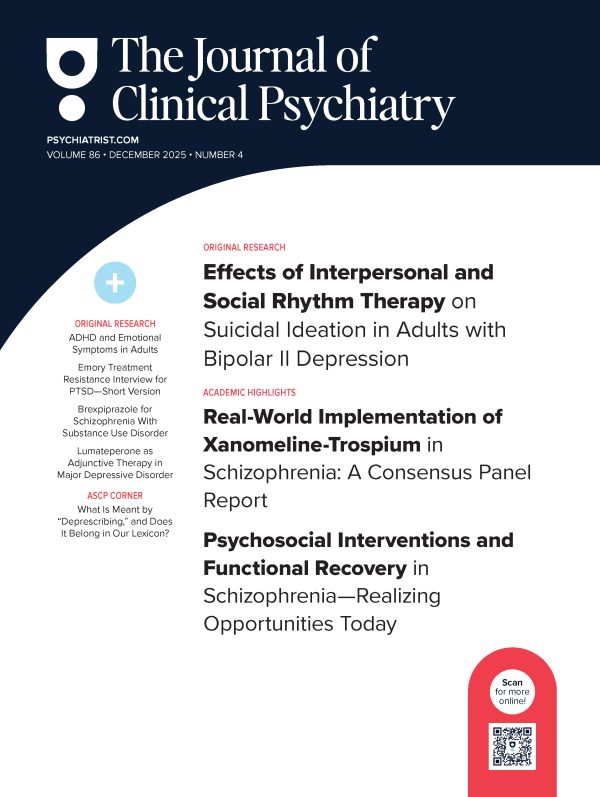Abstract
Objectives: To examine differences in treatment use and preference among women with mood disorders based on race, ethnicity, and type of health insurance.
Methods: Women (N = 2,877) with depression, anxiety, and bipolar disorders were surveyed in primary care and specialty clinics affiliated with the National Network of Depression Centers from January 2018 to December 2020. Logistic regression was employed to examine the probabilities of Black, White, and Hispanic women, who varied on public (government-funded) vs private insurance, using and preferring medication, psychotherapy, or complementary treatments.
Results: Black women had lower odds of receiving medications for treatment of all mood disorders, while White women had higher odds. For example, in treatment of depression, the odds ratio (OR) for Black women was 0.435 (P=.011), while the OR for White women was 2.048 (P=.009). Hispanic women had higher odds of using complementary treatments than other women. For example, in treatment of anxiety, their OR was 2.346 (P=.008). Across mood disorders, government-funded (Medicaid/Medicare) coverage was associated with greater use of psychotherapy and complementary treatments (ORs ranging from 1.529 to 5.011) as well as greater medication use for bipolar disorder (OR=5.805, P=.027). Psychotherapy was preferred by the majority of all women (55.5%), although preferences for other treatments differed between racial/ethnic groups.
Conclusions: Research is needed regarding the degree to which clinicians are offering varied treatments to diverse women with mood disorders and how clinicians consider women’s preferences. Results highlight the necessity for treatment that integrates culturally based values and preferences, along with policies that ensure treatment access for women who are privately insured.
J Clin Psychiatry 2025;86(3):25m15823
Author affiliations are listed at the end of this article.
Members Only Content
This full article is available exclusively to Professional tier members. Subscribe now to unlock the HTML version and gain unlimited access to our entire library plus all PDFs. If you’re already a subscriber, please log in below to continue reading.
References (58)

- GBD 2019 Mental Disorders Collaborators. Global, regional, and national burden of 12 mental disorders in 204 countries and territories, 1990–2019: a systematic analysis for the Global Burden of Disease Study 2019. Lancet Psychiatry. 2022;9(2):137–150. PubMed CrossRef
- Seney ML, Sibille E. Sex differences in mood disorders: perspectives from humans and rodent models. Biol Sex Differ. 2014;5:17–10. PubMed CrossRef
- Rubinow DR, Schmidt PJ. Sex differences and the neurobiology of affective disorders. Neuropsychopharmacology. 2019;44(1):111–128. PubMed CrossRef
- Villamil Grest C, Siantz E, Cederbaum J. Behavioral health services use among racial and ethnic groups: results from the California Health Interview Survey (CHIS). J Immigr Minor Health. 2022;24(1):118–124. PubMed CrossRef
- Ertel KA, Rich-Edwards JW, Koenen KC. Maternal depression in the United States: nationally representative rates and risks. J Womens Health. 2011;20(11):1609–1617. PubMed CrossRef
- Boyd RC, Joe S, Michalopoulos L, et al. Prevalence of mood disorders and service use among US mothers by race and ethnicity: results from the National Survey of American Life. J Clin Psychiatry. 2011;72(11):1538–1545. PubMed CrossRef
- Dagher RK, Pérez-Stable EJ, James RS. Socioeconomic and racial/ethnic disparities in postpartum consultation for mental health concerns among US mothers. Arch Womens Ment Health. 2021;24(5):781–791. PubMed CrossRef
- Walker ER, Cummings JR, Hockenberry JM, et al. Insurance status, use of mental health services, and unmet need for mental health care in the United States. Psychiatr Serv. 2015;66(6):578–584. PubMed CrossRef
- Wharam JF, Busch AB, Madden J, et al. Effect of high-deductible insurance on health care use in bipolar disorder. Am J Manag Care. 2020;26(6):248–255. PubMed CrossRef
- Terlizzi EP, Zablotsky B. Mental health treatment among adults: United States, 2019. NCHS Data Brief. 2020(380):1–8. PubMed
- Haight SC, Daw JR, Martin CL, et al. Racial and ethnic inequities in postpartum depressive symptoms, diagnosis, and care in 7 US jurisdictions: study examines racial and ethnic inequities in postpartum depressive symptoms, diagnosis, and care. Health Aff. 2024;43(4):486–495. PubMed CrossRef
- Kozhimannil KB, Trinacty CM, Busch AB, et al. Racial and ethnic disparities in postpartum depression care among low-income women. Psychiatr Serv. 2011;62(6):619–625. PubMed CrossRef
- Sonik RA, Creedon TB, Progovac AM, et al. Depression treatment preferences by race/ethnicity and gender and associations between past healthcare discrimination experiences and present preferences in a nationally representative sample. Soc Sci Med. 2020;253:112939. PubMed CrossRef
- Hansen MED, Tobón AL, Haider UK, et al. The Role of Perinatal Psychiatry Access Programs in Advancing Mental Health Equity. Elsevier; 2023.
- Hahm HC, Cook BL, Ault-Brutus A, et al. Intersection of race-ethnicity and gender in depression care: screening, access, and minimally adequate treatment. Psychiatr Serv. 2015;66(3):258–264. PubMed CrossRef
- Copeland VC, Snyder K. Barriers to mental health treatment services for low-income African American women whose children receive behavioral health services: an ethnographic investigation. Soc Work Public Health. 2011;26(1):78–95. PubMed CrossRef
- Gaston GB, Earl TR, Nisanci A, et al. Perception of mental health services among Black Americans. Soc Work Ment Health. 2016;14(6):676–695. CrossRef
- Leis JA, Mendelson T, Perry DF, et al. Perceptions of mental health services among low-income, perinatal African-American women. Women’s Health Issues. 2011;21(4):314–319. PubMed CrossRef
- Nelson T, Shahid NN, Cardemil EV. Do I really need to go and see somebody? Black women’s perceptions of help-seeking for depression. J Black Psychol. 2020;46(4):263–286. CrossRef
- Nicolaidis C, Timmons V, Thomas MJ, et al. “You don’t go tell white people nothing”: African American women’s perspectives on the influence of violence and race on depression and depression care. Am J Public Health. 2010;100(8):1470–1476. PubMed CrossRef
- Collado A, Lim AC, MacPherson L. A systematic review of depression psychotherapies among Latinos. Clin Psychol Rev. 2016;45:193–209. PubMed CrossRef
- Salcedo S, McMaster KJ, Johnson SL. Disparities in treatment and service utilization among Hispanics and non-Hispanic whites with bipolar disorder. J Racial Ethn Health Disparities. 2017;4(3):354–363. PubMed CrossRef
- Lara-Cinisomo S, Clark CT, Wood J. Increasing diagnosis and treatment of perinatal depression in Latinas and African American women: addressing stigma is not enough. Women’s Health Issues. 2018;28(3):201–204. PubMed CrossRef
- Lara-Cinisomo S, Fujimoto EM, Oksas C, et al. Pilot study exploring migration experiences and perinatal depressive and anxiety symptoms in immigrant Latinas. Matern Child Health J. 2019;23(12):1627–1647. PubMed CrossRef
- Soto Mas F, Jacobson HE. Advancing health literacy among Hispanic immigrants: the intersection between education and health. Health Promot Pract. 2019;20(2):251–257. PubMed CrossRef
- Lara-Cinisomo S, Wisner KL, Burns RM, et al. Perinatal depression treatment preferences among Latina mothers. Qual Health Res. 2014;24(2):232–241. PubMed CrossRef
- Cook BLPA, Cortés DE, McCormick D, et al. Comparing Preferences for Depression and Diabetes Treatment among Adults of Different Racial and Ethnic Groups Who Reported Discrimination in Health Care. 2021. Accessed August 6, 2024. https://www.pcori.org/research-results/2016/comparing-preferences-depression-and-diabetes-treatment-among-adults-different-racial-and-ethnic-groups-who-reported-discrimination-health-care
- Guth M, Garfield R, Rudowitz R. The effects of Medicaid expansion under the ACA: updated findings from a literature review. Kaiser Family Foundation. 2020;37(6):944–950.
- Donohue J, Cole ES, James CV, et al. The US Medicaid program: coverage, financing, reforms, and implications for health equity. JAMA. 2022;328(11):1085–1099. PubMed CrossRef
- El-Nahal W. An overview of Medicare for clinicians. J Gen Intern Med. 2020;35(12):3702–3706. PubMed CrossRef
- Baker-Ericzén MJ, Connelly CD, Hazen AL, et al. A collaborative care telemedicine intervention to overcome treatment barriers for Latina women with depression during the perinatal period. Fam Syst Health. 2012;30(3):224. PubMed CrossRef
- Mahajan S, Caraballo C, Lu Y, et al. Trends in differences in health status and health care access and affordability by race and ethnicity in the United States, 1999–2018. JAMA. 2021;326(7):637–648. PubMed CrossRef
- Jun H, Mattke S, Chen A, et al. The value of Medicare coverage on depressive symptoms among older immigrants. Gerontologist. 2024;64(2):gnad070. PubMed CrossRef
- Fry CE, Sommers BD. Effect of Medicaid expansion on health insurance coverage and access to care among adults with depression. Psychiatr Serv. 2018;69(11):1146–1152. PubMed CrossRef
- Zuvekas SH, McClellan CB, Ali MM, et al. Medicaid expansion and health insurance coverage and treatment utilization among individuals with a mental health condition. J Ment Health Pol Econ. 2020;23(3):151–182. PubMed
- Hockenberry J, Wen H, Druss BG, et al. No improvement in mental health treatment or patient-reported outcomes at Medicare ACOs For Depression And Anxiety Disorders. Health Aff. 2023;42(11):1478–1487. PubMed CrossRef
- Gliske K, Berry KR, Ballard J, et al. Mental health outcomes for youths with public versus private health insurance attending a telehealth intensive outpatient program: quality improvement analysis. JMIR Form Res. 2022;6(11):e41721. PubMed CrossRef
- Busch SH, Kyanko K. Assessment of perceptions of mental health vs medical health plan networks among US adults with private insurance. JAMA Netw Open. 2021;4(10):e2130770–e2130770. PubMed CrossRef
- Rowan K, McAlpine DD, Blewett LA. Access and cost barriers to mental health care, by insurance status, 1999–2010. Health Aff. 2013;32(10):1723–1730. PubMed CrossRef
- Weiss SJ, Flynn H, Christian L, et al. Symptom profiles of women at risk of mood disorders: a latent class analysis. J Affect Disord. 2021;295:139–147. PubMed CrossRef
- Coleman KJ, Stewart C, Waitzfelder BE, et al. Racial-ethnic differences in psychiatric diagnoses and treatment across 11 health care systems in the mental health research network. Psychiatr Serv. 2016;67(7):749–757. PubMed CrossRef
- McGregor B, Li C, Baltrus P, et al. Racial and ethnic disparities in treatment and treatment type for depression in a national sample of Medicaid recipients. Psychiatr Serv. 2020;71(7):663–669. PubMed CrossRef
- Johnson KR, Johnson SL. Inadequate treatment of Black Americans with bipolar disorder. Psychiatr Serv. 2014;65(2):255–258. PubMed CrossRef
- Akinhanmi MO, Biernacka JM, Strakowski SM, et al. Racial disparities in bipolar disorder treatment and research: a call to action. Bipolar Disord. 2018;20(6):506–514. PubMed CrossRef
- Green RR, Santoro N, Allshouse AA, et al. Prevalence of complementary and alternative medicine and herbal remedy use in Hispanic and non-Hispanic white women: results from the study of women’s health across the nation. J Altern Complement Med. 2017;23(10):805–811. PubMed CrossRef
- Rhee TG, Evans RL, McAlpine DD, et al. Racial/Ethnic differences in the use of complementary and alternative medicine in US adults with moderate mental distress: results from the 2012 National Health Interview Survey. J Prim Care Community Health. 2017;8(2):43–54. PubMed CrossRef
- Dillon FR, Ertl MM, Corp DA, et al. Latina young adults’ use of health care during initial months in the United States. Health Care Women Int. 2018;39(3):343–359. PubMed CrossRef
- Wallace PM, Torres S, Beltran J, et al. Views of mammography screening among US Black and Hispanic immigrant women and their providers. Health Care Women Int. 2014;35(10):1181–1200. PubMed CrossRef
- Dieleman J, Cao J, Chapin A, et al. US health care spending by payer and health condition, 1996-2016. JAMA. 2020;323(9):863–884. PubMed CrossRef
- Fusco N, Sils B, Graff JS, et al. Cost-sharing and adherence, clinical outcomes, health care utilization, and costs: a systematic literature review. J Manag Care Spec Pharm. 2023;29(1):4–16. PubMed CrossRef
- Presskreischer R, Barry CL, Lawrence AK, et al. Factors affecting state-level enforcement of the Federal Mental Health Parity and Addiction Equity Act: a cross-case analysis of four states. J Health Polit Policy Law. 2023;48(1):1–34. PubMed CrossRef
- McHugh RK, Whitton SW, Peckham AD, et al. Patient preference for psychological vs pharmacologic treatment of psychiatric disorders: a meta-analytic review. J Clin Psychiatry. 2013;74(6):595–602. PubMed CrossRef
- Dorow M, Löbner M, Pabst A, et al. Preferences for depression treatment including internet-based interventions: results from a large sample of primary care patients. Front Psychiatry. 2018;9:181. PubMed CrossRef
- Givens JL, Houston TK, Van Voorhees BW, et al. Ethnicity and preferences for depression treatment. Gen Hosp Psychiatry. 2007;29(3):182–191. PubMed CrossRef
- National Academies of Sciences Engineering, and Medicine. Improving representation in clinical trials and research: building research equity for women and underrepresented groups. 2022. PubMed CrossRef
- Neal-Barnett A, Stadulis R, Murray M, et al. Sister circles as a culturally relevant intervention for anxious African American women. Clin Psychol. 2011;18(3):266–273. PubMed CrossRef
- Fongwa MN, dela Cruz FA, Hays RD. African American women’s perceptions of the meaning of support groups for improving adherence to hypertension treatment: a conceptual model. Nurs Open. 2019;6(3):860–870. PubMed CrossRef
- Ghaddar S, Vatcheva KP, Alvarado SG, et al. Understanding the intention to use telehealth services in underserved Hispanic border communities: cross-sectional study. J Med Internet Res. 2020;22(9):e21012. PubMed CrossRef






